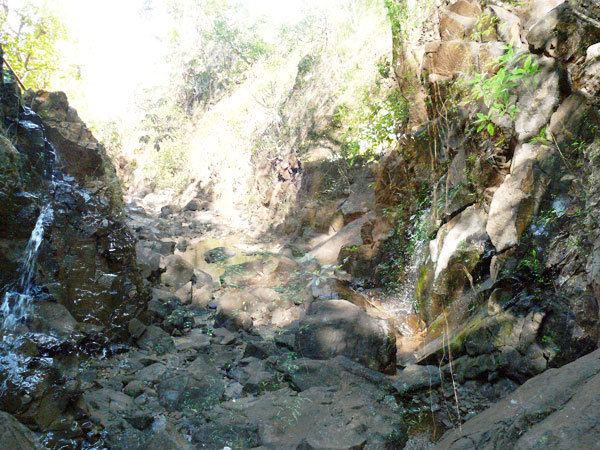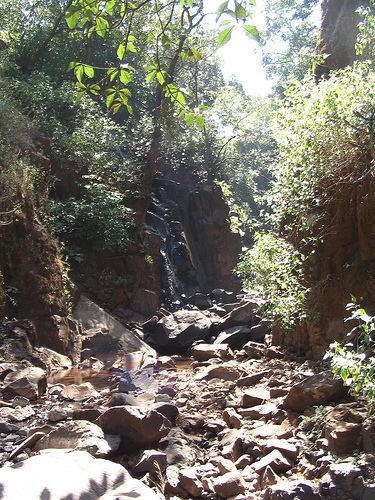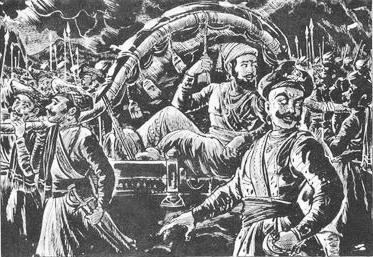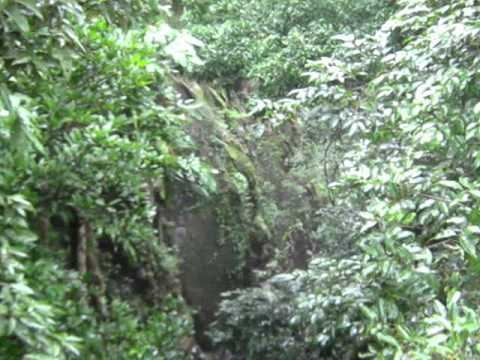300 10,000 Date 13 July 1660 Result Adilshahi victory | 200+ 1,400+ | |
 | ||
Similar Battle of Pratapgarh, Battle of Sinhagad, Battle of Laswari, Siege of Bharatpur, Battle of Khadki | ||
Battle of Pävankhind was a rearguard battle and a last stand that took place on July 13, 1660 at a mountain pass in the vicinity of fort Vishalgad, near the city of Kolhapur, Maharashtra, India between the Maratha sardar Baji Prabhu Deshpande and Siddi Masud of Adilshah.

In 1660, Shivaji was trapped in the fort of Panhala, under siege and vastly outnumbered by an Adilshahi army led by an Abyssinian named Siddi Masud. The Adilshahis were the dynasty which ruled Bijapur for many centuries. The ruler at the time was Ali Adil Shah II.

Shivaji had inflicted embarrassing defeats upon the Adilshahis, and they were determined to crush him. The Adilshahis were often at odds with the Moghuls, but in this case they were aligned with the Moghuls with the joint purpose of crushing the overly audacious and crafty Shivaji.

An ambitious plan was hatched by Shivaji to escape to the fort of Vishalgadh, which was administered by a Maratha chieftain named Range Narayan Orpe, who was under allegiance to the Adilshahis, but who had come to a clandestine arrangement to switch sides and join Shivaji at an opportune moment. There was also a Moghul garrison stationed at Vishalgadh which Shivaji would have to defeat. Shivaji waited for months, planning and depleting the Adilshah's food source. He waited until he knew they needed to gather more food, and then started his plan.

Shivaji, Baji Prabhu and around 600 of their best troops, hardened mountaineers of the Maval region, would dash through the Adilshahi force at night. A man named Shiva Kashid, who resembled Shivaji in appearance, had volunteered to dress like the king and get captured. It was envisaged that this would buy some additional time, before Siddi Masud realised the error an gave chase.
Shivaji made his escape on the dark night of July 13, with the small contingent of troops. Baji Prabhu was 2ndin command of the contingent. Baji Prabhu would have perhaps won no place in history and ended his life in relative obscurity if Shivaji and his party had managed a good lead towards their destination. But the Adilshahis gave hot and rapid pursuit, with an army of 10,000. It was clear that there was no way to shake of the enemy, and that the Marathas would not simultaneously prevail over both the Moghul garrison at Vishagadh and the chasing Adilshahi army.
The only option was for a section of the Marathas to stay back and fight the vastly larger Adilshahi forces, while the rest of the Marathas would carry on. Shivaji decided that this was inevitable. Baji Prabhu agreed to face the troops of Bijapur with half of the contingent. Shivaji said that Baji Prabhu would hear the cannon fire from Vishalgadh (the destination fort), as a signal of Shivaji’s safety. The strategic position of Ghod Khind (Horse Pass) was chosen for the defence. It was very narrow and only a few soldiers could pass at any one time.
Baji Prabhu occupied Ghod Khind, blocking the path of the pursuers, and made a determined stand against them. He knew the great importance of his task – he had to protect the safety of a man of destiny. He was resolved to stand until the last man, outnumbered vastly. Baji Prabhu was severely wounded but carried on fighting for hours, possessed as it were by his sense of mission. The Adilshahi army repeatedly tried to break through the defenses of the pass, but were constantly repulsed. The unequal battle raged for hours, with the valiant defenders clinging to their positions, rapidly depleting in numbers. Only a handful of Marathas survived, and around over a thousand soldiers of the Adilshahi army were slain.
At last, 5 hours after the battle started, the cannon fire announcing Shivaji’s return to Vishalgadh was heard. Hundreds of valiant Marathas had by then laid down their lives. Baji Prabhu was fatally wounded and died. The dying hero was however jubilant.
Shivaji’s plan was successful. Having made his way to Vishalgadh, Range Narayan Orpe switched sides and the combined Maratha forces easily surprised and routed the ill-prepared Moghul garrison situated there. Baji Prabhu had earned them a breather before the Adilshahi forces arrived which had carried on chasing Shivaji to Vishalgadh. The Marathas repulsed the Adilshahis inflicting heavy losses upon the latter.
Shivaji later personally visited the house of the slain Baji Prabhu, which was in the village of Kasabe Sindh in the Raigad district and honoured his family, including giving his eldest son a position of leadership and honour in the forces.
The defence of the pass of Ghor Khind by 300 Marathas led by Baji Prabhu was renamed “The Battle of Pavan Khind” which in Marathi means “The Battle of the Sacred Pass”.
“The defence…,” says historian Dennis Kincaid, “has become legendary in Western India. The action is remarkable as an example of the spirit which Shivaji’s leadership infused into his followers.” Shivaji’s mother, Jijabai, wept at the news of Baji Prabhu’s death. Ballads and poems have been composed in his memory, some of which are still sung today. Sri Aurobindo, the great yogi, mystic and revolutionary of the 20th century wrote a splendid poem dedicated to Baji Prabhu, which was used as a symbol to capture the spirit of sacrifice that was required of the young men in India’s freedom struggle which was then under way.
Eminent historian Jadunath Sarkar describes the incident in his book "Shivaji and His Times" in the following way.
"The siege dragged on for nearly four months ; all the paths of ingress and egress were closed to the garrison. Shivaji found himself in a fatal trap. So, he wrote a secret letter to Jauhar, deceitfully begging his protection and offering to make an alliance with him. In order to negotiate for the terms he asked for a passport. Jauhar, "who was both fool and traitor," swallowed the bait ; he assured Shivaji of his protection, gave him a safe conduct, and flattered himself that with Shiva for an ally he would be able to create a kingdom of his own in independence of Adil Shah. Next day Shivaji with only two or three followers visited Jauhar at midnight, and was received in darbar. After oaths of co-operation had been taken on both sides, Shivaji returned quickly to the fort, and the pretended siege was continued. When the news of Jauhar's treacherous coquetting with Shiva reached the ears of Ali Adil Shah, that king burst into anger and left his capital (5th August) "to punish both the rebels." An envoy was sent to bring Jauhar back to the right path, but the mission was a failure. When, however, Ali reached Miraj and his Vanguard advanced beyond it still nearer to Panhala, Shivaji slipped out of the fort one night with his family and 5 to 6 thousand soldiers, and Panhala returned to Adil Shah's possession without a blow (about 25th August, 1660.) As the Bijapur Court-poet sang in exultation, "Ali took Panhala from Salabat in a twinkle." (Tarikh-i-Ali, 82-93 ; B. S. 353-357 ; F. R. Rajapur, Kolhapur to Sural, dated 5 June. 1660. Chit. 64 ; Dig. 175-176 ; T. S. I8b-19a.)
Shiva's escape from the fort was soon detected, and a strong Bijapuri force under Jauhar's son Siddi Aziz and Afzal Khan's son Fazl Khan set out in pursuit of him. On reaching a narrow ravine (probably near Malkapur), Shiva left 5 thousand men there under Baji Pradhu (the deshpande of Hardis Maval) with orders to hold the mouth of the pass at all costs till the main body of the fugitives had reached Vishalgarh. The Bijapuris delivered three bloody assaults on the heroic rear-guard, all of which were beaten off. But when at last the gun-fire from Vishalgarh gave the anxiously expected signal that Shivaji had reached safety within its walls, the gallant Baji Prabhu was lying mortally wounded with 700 of his followers. The faithful servant had done his appointed duty. The Bijapuris declined to besiege Vishalgarh, and retired to their own territory, after recovering Pavangarh and some other forts in addition to Panhala. Shiva retained in that quarter only the forts of Rangana and Vishalgarh. [Chil. 64-65; Dig. 182-185; T. S. 19a & b; the name of Siddi Aziz is given by Duff (i. 181) only, while T, 5. reads Siddi Halal. The Persian works are absolutely silent about this retreat. Vishalgarh is 27 miles from Panhetla via Malkapur. (Ind. At. 40 S. W.)]"
